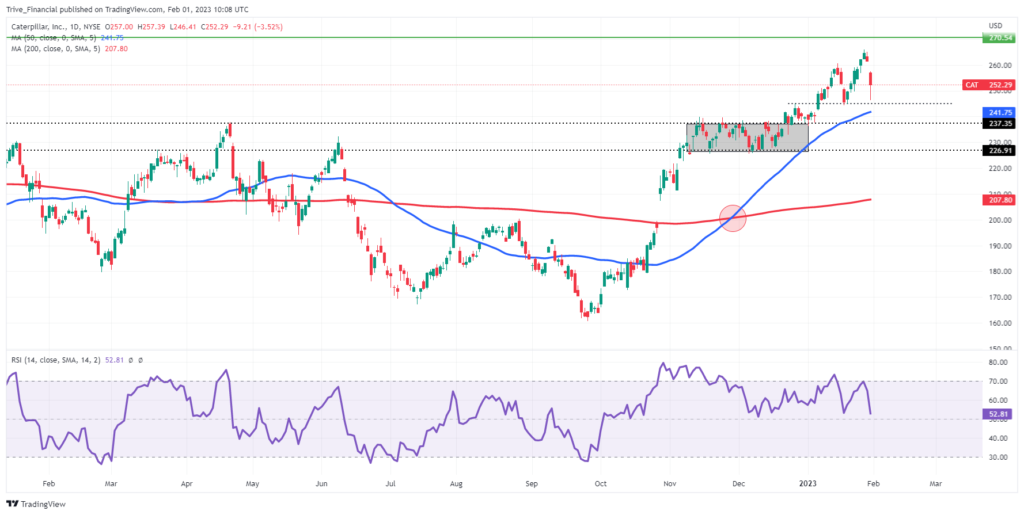Caterpillar (NYSE: CAT) have established itself as a world leader in manufacturing equipment for mining and construction. After missing analyst expectations for earnings for the first time since the pandemic, the share plummeted towards its most significant drop in four months as investors are concerned about its growth potential in an economy heading towards a recession.
Caterpillar recorded revenue for the quarter of $16,6Bn, beating estimates of $16Bn. Operating margins of 17% were higher than the consensus of 16,8%, but the miss that drove earnings down was the earnings per share, coming in at $3,86 compared to expectations of $4,05.
Technical
After a bull rally that started in October of 2022, the price consolidated between $226,91 and $237,35 per share early on in the year. Consolidation between these levels was seen before in march o 2021 when the market heavily resisted the upper level of consolidation. Since then, the market has respected those levels, and a breakout above the $237,35 level was just recently seen. In the first week of January, the share price broke out above that resistance level and has since retested at higher support before trending higher. The golden cross that took place as the price consolidated and traded above its 50-day moving average suggests there is still bullish momentum for the stock. The price was down 3,5% after the earnings miss, as the higher support level at $245,04 is getting retested. If fundamentals hold, this could be a potential long-term entry point for an investor, with the eventual estimated target price of $270,54 in mind.

Fundamentals
Caterpillar has gained the attention of investors, causing a bull rally from the end of 2022 through to the early stages of 2023. Fundamentally, numerous factors contributed to this bullish outlook. They have established themselves as an industry leader in their operation of autonomous trucks. In February 2022, they announced a milestone of operating over 500 autonomous trucks worldwide. These trucks are said to be safer than driver-operated trucks and have improved performance by up to 30% compared to used trucks. Even toward the end of 2021, the company safely hauled over four bn tons and travelled over 145km autonomously, which significantly outshines any competitor they have.
Further investment into electric mining trucks has also been giving them a competitive advantage in the industry. Furthermore, Caterpillar has established itself and created a strong presence in emerging market economies. As the demand for industrialization increases, growth opportunities will continue to present themselves in those regions. With more exposure to infrastructure development programs, they are poised to take advantage of increased demand in those areas. The demand for their equipment will also likely remain high for the foreseeable future as the green energy trend depends on the economy’s metal mining ability. The energy transition increases the demand for commodities. The numbers in their latest earnings report show that CAT showed resilience and strength across all their segments. Sales in the fourth quarter were up significantly in all segments. Their backlog also grew by $7,4 million from the fourth quarter of 2021. The resource industries segment was a particular area of focus to drive growth within the company. Total sales for the segment were up 26%, with a 110% increase in segment profit. This showed further pent-up demand for their equipment and aftermarket parts, aided by favourable price realization and a larger sales volume. Overall, Caterpillar showed a robust top-line performance. Their bottom line was affected by increased costs and foreign exchange headwinds. A decent amount of their earnings miss is allocated to foreign exchange movements as a strong dollar ate into their operating margins. However, fundamentally nothing has changed about the way the business operates, and with a lot of talk about the dollar potentially peaking, this problem is not likely to persist.
However, increasing manufacturing and material costs will likely remain as the battle against inflation continues. From a fundamental perspective, they generate consistent free cash flows and operate under a healthy balance sheet, pointing all signs toward a buy. However, they appear to be overvalued compared to industry peers. At a forward P/E of 17x compared to Deere & Company (15x) and Terex Corporation (10,7x), investors are concerned about whether such a high price justifies the company’s ability to generate profit. Especially in the current macroeconomic environment, which is undoubtedly a headwind for the construction and industrial industry. However, what sets Caterpillar apart is their robust dividend policy. This quarter rounded up the 29th consecutive year in which the company paid out higher dividends to its shareholders. They currently have a dividend payout ratio of more than 30% and paid out $6,7Bn to their shareholders in 2022. This is an attractive feature as a source of return is still generated even through recessionary selloffs, which makes it more justifiable in the current market.
Summary
Caterpillar has seen their share price plummet on Tuesday after its earnings miss. Investors are also concerned for the industry as the economy is heading into a recession. However, the company is strong fundamentally, and even though more downside is on the cards, it could lead to potential entry opportunities for long-term investors with an eventual estimated target price of $270,54.

